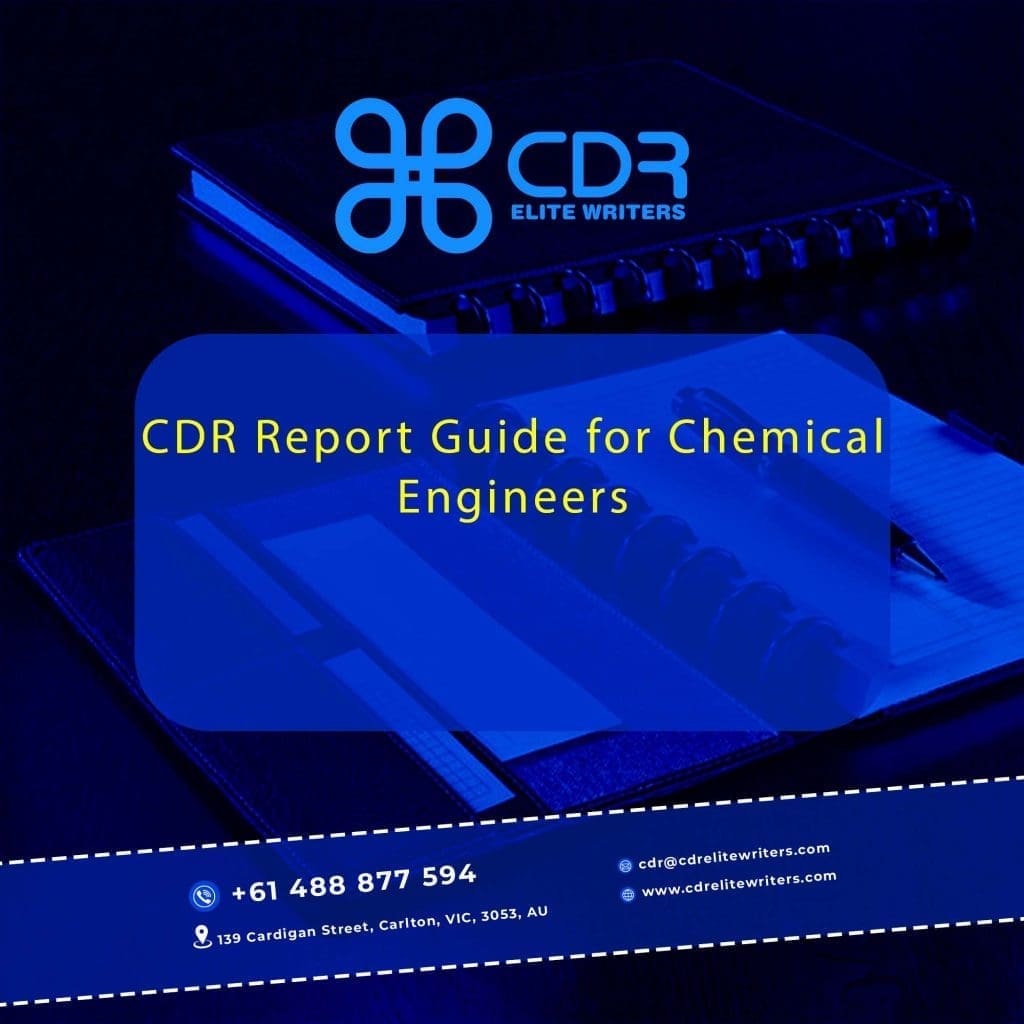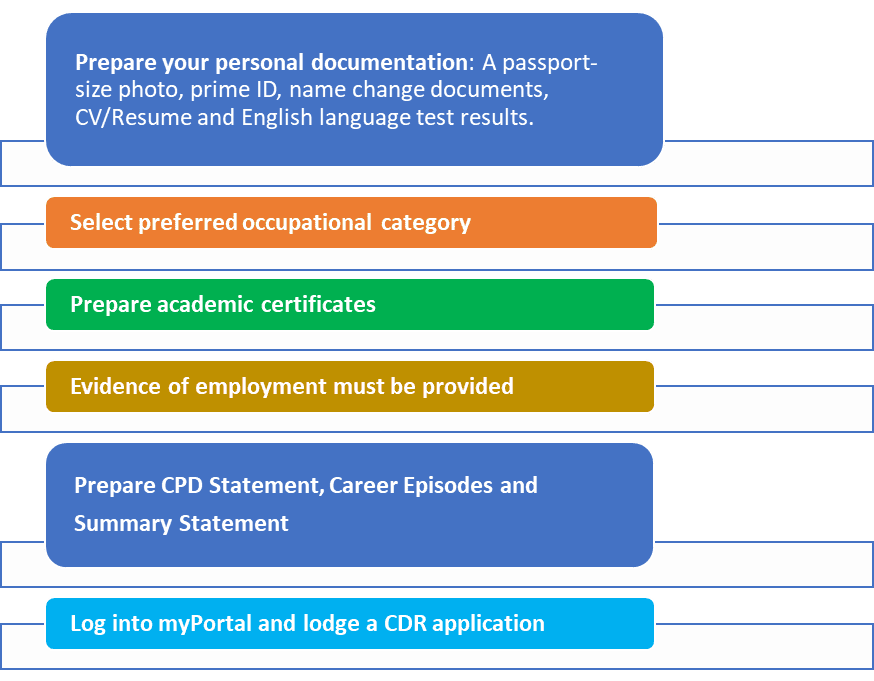Introduction
The preparation of a Competency Demonstration Report (CDR Report) is a crucial step for Chemical Engineers aspiring to establish their careers in Australia. This document serves as a pivotal tool in the migration skills assessment process, conducted by Engineers Australia. It is designed to meticulously evaluate the applicant’s engineering knowledge, skills, and competencies against the Australian standards for engineering practice.
Specifically for Chemical Engineers, the CDR is an opportunity to showcase their technical prowess in designing, implementing, and optimizing chemical processes and systems, thereby affirming their eligibility and readiness to contribute significantly to Australia’s engineering sector. In essence, an effectively crafted CDR can dramatically enhance the prospects of acquiring a skilled migration visa, paving the way for a promising career in Australia.

Table of Contents
ANZSCO Code 233111 and Its Relevance to Chemical Engineers
The ANZSCO code 233111 corresponds to Chemical Engineers in Australia and New Zealand. This code is of paramount importance for professionals specializing in Chemical Engineering and Material Engineering who are contemplating migrating to Australia for career advancement.
As per the ANZSCO standard, a chemical engineer’s role encompasses designing and formulating specifications for chemical process systems, supervising the construction and operation of large-scale chemical plants, overseeing industrial processing, and managing the production of products undergoing chemical transformations. Moreover, chemical engineers conduct research on the properties of metals, ceramics, polymers, and other materials to assess and enhance their engineering and commercial applications, contributing significantly to various industries.
Tasks involved in this role include:
- Developing designs for chemical process systems and designing control systems for various processes, like those facilitating component separation, chemical transformations, fuel testing, heat transfer, and solid, liquid, and gas handling.
- Responsible for supervising the operation and maintenance of equipment to guarantee optimal efficiency and safety standards are met. This includes conducting regular inspections, implementing preventive maintenance measures, and ensuring compliance with all safety protocols to uphold a secure working environment.
- Ensuring the use of suitable materials and equipment that align with the required specifications is vital for maintaining quality standards and operational efficiency in the manufacturing process.
- Identifying and effectively addressing malfunctions in chemical plants is crucial to ensure operational efficiency and safety. By promptly detecting issues such as leaks, pressure fluctuations, or equipment failures, plant operators can proactively mitigate risks and maintain the smooth functioning of the facility. Regular monitoring and thorough troubleshooting procedures are key in preventing potential disruptions and optimizing plant performance.
- Researching product utilization and pollution control issues to develop sustainable solutions that benefit both the environment and society.
- Assessing new product plans and recommending material choices based on design specs, considering factors like strength, weight, and cost.
- Orchestrating laboratory procedures to innovate new materials and fabrication methods that meet production standards.
- Collaborating with material producers to evaluate materials suitable for specific applications.
- Analyzing product failure data, conducting lab tests to identify causes, and providing solutions to resolve issues effectively.
Structuring Each Career Episode

Each Career Episode should be structured methodically to provide a coherent and detailed account of your professional engineering experience. A well-crafted Career Episode comprises four main sections:
- Introduction (Approximately 100 words): Briefly outline the timeframe and location of the project, your position title, and your employer. This section sets the context for the Career Episode.
- Background (200-500 words): Provide detailed background information on the project. Describe the project objectives, the work environment, and your role and responsibilities within the project. Highlight the engineering problems or challenges that the project aimed to address.
- Personal Engineering Activity (600-1500 words): This is the core of your Career Episode, where you describe in detail your engineering activities. Discuss how you applied your knowledge and skills to the project, emphasizing your personal contributions. Illustrate how you approached and solved problems, designed processes, and/or applied innovative solutions. Use specific examples to demonstrate your role in achieving the project’s objectives.
- Summary (50-100 words): Conclude with a summary of the project’s overall outcome and your personal contribution towards these achievements. Reflect on what you learned from the experience and how it contributed to your development as a Chemical Engineer.
In each Career Episode, it is vital to highlight your problem-solving skills, innovation, and significant contributions to engineering projects. Engineers Australia values evidence of your ability to tackle complex engineering challenges creatively and effectively. Demonstrating your capability to innovate—whether through the development of novel processes, the implementation of cost-saving strategies, or the application of new technologies—underscores your value as a progressive Chemical Engineer. Your Career Episodes should unequivocally reflect your aptitude for engineering excellence, showcasing your potential to contribute to Australia’s engineering sector at the highest level.
Chemical Engineering Project Topic Samples
Selecting an appropriate project topic is a crucial initial step for any Chemical Engineer looking to demonstrate their industry-relevant expertise and innovation capabilities. This section offers a range of project ideas that match industry trends and present challenges for innovative solutions.

Develop a process that minimizes the environmental impact of producing a specific chemical, such as ammonia or sulfuric acid, while maintaining efficiency and cost-effectiveness.
1. Sustainable Production Processes for Chemicals: Develop a process that minimizes the
environmental impact of producing a specific chemical, such as ammonia or sulfuric acid, while
while maintaining efficiency and cost-effectiveness.
- Innovative Waste Management Solutions: Design and implement a waste management system for an industrial facility, utilizing sustainable practices and technologies to minimize the environmental impact and maximize resource recovery.
- Advanced Process Control for Chemical Plants: Develop a control system that uses real-time data to optimize process conditions, resulting in improved efficiency and reduced downtime for chemical plants.
- Green Energy Production using Renewable Resources: Design a process for producing energy from renewable resources, such as biomass or solar power, while minimizing waste production and maximizing energy conversion efficiency.
- Development of Novel Biomaterials for Medical Applications: Use chemical engineering principles to design and produce biomaterials with unique properties, suitable for various medical applications, such as drug delivery or tissue engineering.
- Upgrading Existing Process Plants through Modernization and Optimization: Identify opportunities for process plant optimization by incorporating modern technologies and innovative solutions to improve safety, efficiency, and cost-effectiveness.
- Implementation of Risk Management Strategies in Chemical Plants: Develop and implement a risk management plan for a chemical plant, utilizing your knowledge of process safety and hazard analysis techniques to minimize the potential for accidents and ensure regulatory compliance.
- Designing Sustainable Water Treatment Systems: Use your expertise in chemical engineering to design an efficient and sustainable water treatment system that meets regulatory standards and minimizes the environmental impact.
- Integrating Circular Economy Principles in Chemical Production Processes: Apply circular economy principles to redesign chemical production processes, minimizing waste and maximizing resource efficiency.
- Innovative Solutions for CO2 Capture and Utilization: Develop a process for capturing carbon dioxide from industrial emissions and converting it into useful products
Crafting the CDR Summary Statement
The CDR Summary Statement is a critical and concise document that serves as an overview, mapping specific competencies to the career episodes detailed in your application. It distinctly aligns your demonstrated engineering skills and knowledge with the competency elements required by Engineers Australia. This document facilitates the assessors’ understanding of your engineering capabilities and ensures a streamlined evaluation process. To construct an effective Summary Statement, you must thoroughly analyze each of your career episodes, identifying and listing key instances where you have demonstrated the competencies Engineers Australia seeks.

Strategy for Effectively Cross-Referencing Competencies:
- Review Competency Elements: Begin by familiarizing yourself with the competency elements outlined by Engineers Australia. Understand the depth and breadth of what is expected in each element.
- Identify Specific Examples: For each competency element, identify specific examples from your Career Episodes that illustrate how you have demonstrated that competency. Be precise and use clear references to the relevant section of the episode.
- Use the Correct Format: Engineers Australia provides a specific format for the Summary Statement. Adhere strictly to this format, using the designated codes and descriptions for each competency element.
- Be Concise yet Comprehensive: While the Summary Statement is an overview, it should provide sufficient detail to allow assessors to quickly locate the evidence of competencies in your Career Episodes. Ensure each reference is accurate and directs assessors to the specific parts of your episodes that demonstrate the competency.
- Double-Check for Alignment: After completing your Summary Statement, review it alongside your Career Episodes to ensure consistency and alignment. Each competency reference in the Summary Statement should accurately reflect your demonstrated skills and knowledge as described in your Career Episodes.
By meticulously cross-referencing competencies with the Engineers Australia competency elements in your Summary Statement, you effectively highlight your engineering expertise. This approach not only showcases your professional development but also aligns with the stringent requirements for Skills Assessment, positioning you as a qualified candidate ready to contribute to Australia’s engineering sector.
Guidelines on Documenting CPD Activities Relevant for Chemical Engineers
Documenting Continuous Professional Development (CPD) is an essential component of the Competency Demonstration Report (CDR) for Chemical Engineers. CPD activities are critical in showcasing an engineer’s commitment to continuous learning and professional growth, thus demonstrating their ability to keep pace with evolving industry standards and technological advancements.
When documenting CPD activities, Chemical Engineers must ensure that the information is clear, concise, and reflective of their engagement in professional development. Each listed activity should include the title of the activity, the date it was undertaken, the provider’s name, and a brief description of the knowledge or skill acquired. It is imperative to focus on activities that contribute directly to the development of professional engineering skills, particularly those that are relevant to the Chemical Engineering field.
Examples of CPD Activities for Chemical Engineers:
- Attendance at Workshops, Seminars, and Technical Presentations: Participation in events focusing on recent advancements in chemical engineering, such as new chemical process technologies, sustainable engineering practices, or safety standards.
- Engagement in Professional Bodies: Active involvement in professional engineering societies, such as Engineers Australia or the Institution of Chemical Engineers (IChemE), including participation in committees or working groups dedicated to chemical engineering.
- Completion of Postgraduate Studies or Professional Courses: Undertaking formal education programs or courses aimed at enhancing specific chemical engineering competencies, such as process optimization, chemical plant design, or environmental management.
- Publication of Professional Papers or Articles: Writing and publishing articles or research papers on relevant chemical engineering topics in recognized industry journals or conference proceedings.
- Development of Work-Related Technical Competencies: Learning new software, methodologies, or technologies that are directly applicable to chemical engineering practice, such as process simulation tools or advanced analytics.
By meticulously recording CPD activities in accordance with the guidelines provided, Chemical Engineers can effectively articulate their dedication to maintaining high professional standards and their capability to contribute innovatively to Australia’s engineering sector.
Document Checklist for CDR Report

Before submitting your application for Engineers Australia Skills Assessment, ensure that you have complied with all requirements and provided complete documentation. This checklist will help you verify the accuracy and completeness of your submission.
1. Competency Demonstration Report (CDR)
- Three Career Episodes
- Summary Statement
- Continuing Professional Development (CPD) list
- Curriculum Vitae (CV)
- English language test results (if applicable)
2. Personal Identification Documents
- Copy of passport
- Passport-sized photo
3. Academic Transcripts and Certificates
- Bachelor’s degree certificate in Engineering or Science
- Postgraduate qualification certificates (if applicable)
Note: All documents should be translated into English, if necessary.
CDR Submission Process
- Create an Engineers Australia online account or log into your existing account.
- Complete the online application form, providing all required information and documents.
- Pay the assessment fee and upload your CDR and other supporting documents.
- Await confirmation of successful submission from Engineers Australia via email.
- Once your CDR has been assessed, you will receive a notification via email regarding your assessment outcome.
- If successful, you will receive a Migration Skills Assessment (MSA) Outcome Letter and can proceed with your visa application process.
- If unsuccessful, you may be given the opportunity to provide additional information or documents for reassessment.
- After receiving a positive MSA Outcome Letter, continue with the final steps of your visa application process.

Following these guidelines and utilizing your engineering expertise to effectively craft your CDR, you can successfully demonstrate your competencies and skills for Engineers Australia Skills Assessment. Remember to adhere strictly to the outlined format and provide accurate information to ensure a smooth assessment process. Good luck on your journey towards becoming a skilled engineer in Australia!
Conclusion
Crafting a comprehensive Competency Demonstration Report (CDR) is vital for engineers planning to work in Australia. It serves as a crucial document to showcase your engineering skills effectively. To create a compelling CDR, engineers should focus on developing detailed Career Episodes that align with Engineers Australia guidelines. These episodes play a significant role in demonstrating your competencies and achievements in the field. Additionally, the Summary Statement acts as a bridge to map out your competencies and provide a cohesive narrative of your engineering journey. By approaching the writing process with confidence, reflecting on your accomplishments, and paying attention to details, you can enhance your chances of success in the competitive engineering landscape of Australia.




